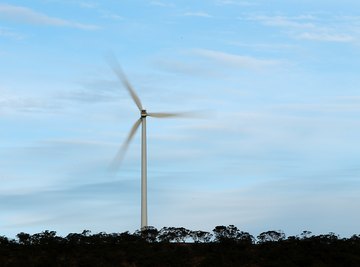
It is often helpful to calculate average values of regular phenomena, in order to have a rough estimate of that quantity.
Average wind speed is such a statistic, due to its relevance to so many human activities. Enthusiasts of sports that rely on the wind – such as kitesurfers – may need to know about average daily wind speeds when planning an outing or selecting a vacation destination.
On a larger scale, the average daily wind speed is used to determine placement of wind turbines for power generation, and to determine flight paths in the aviation industry.
The Facts
Wind is caused by the natural tendency of air to flow from areas of high pressure to areas of low pressure. Generally, average wind speed increases with increasing altitude. Winds are slowest at ground level, and fastest at the level of the jet stream.
Certain factors can influence the average daily wind speed at a particular ground-level location, including obstructions such as buildings or trees and proximity to hills or large bodies of water.
Measuring and Calculating
Wind speed for a particular locale is typically measured using an anemometer. To assess wind speeds at higher altitudes, meteorologists deploy weather balloons. At official National Weather Service and Federal Aviation Administration sites in the U.S., averages are calculated every two minutes, and compiled over a 24-hour period to produce the daily average.
Depending on the intended audience – for instance, scientists, pilots or the general public – the average daily wind speed may be reported in knots, kilometers per hour, or miles per hour. Daily wind speed measurements cannot assess, however, the frequency at which very high winds occur.
In general, most locations on the Earth have daily and seasonal variation of wind speed, thus reporting a daily average may not be sufficient, and a long-term average may be more prudent. This variation is most likely due to the daily and seasonal variation of temperature, which can cause changes in pressure.
Sample Averages
In the U.S., daily wind speeds typically average between 6 and 12 miles per hour (10 and 19 kilometers per hour) throughout the course of a year. These averages vary widely by geographic location. For instance, of major cities, Boston is the windiest, with an average wind speed of 12.3 miles per hour (19.8 kilometers per hour), while Phoenix is the calmest, clocking in at 6.2 miles per hour (10 kilometers per hour), an average about half that of Boston’s.
Geographic and Seasonal Variation
Although there are other factors, a location’s latitude can give a hint as to whether its average daily wind speeds will be high or low. Worldwide, the area near the equator is notoriously calm, known colloquially as “the doldrums.”
The nonequatorial tropics experience strong breezes known as the trade winds, but around 30 degrees latitude, there is often a deficit of wind. Many people assume that daily average wind speeds are highest during the early springtime in most North American locales, but this is not always the case. For instance, Buffalo, N.Y., experiences its highest average daily wind speed in January, while San Francisco is windiest in June.
So is Chicago the Windiest City in the United States?
Chicago, IL has a well known nickname which is "the Windy City," but is the average wind speed in Chicago actually higher than other places in the country?
According to data of wind speeds in June of 2019 taken by the National Oceanic and Atmospheric Association, the average daily wind speed in Chicago was between 3 to 4 m/s, but as high as 8 m/s along the coast of California. Clearly Chicago is not the windiest location in the US, despite the nickname.
References
- The Weather Prediction: What Causes Wind?, Jeff Haby
- Aerostar Wind Turbines: Adjusting Wind Speeds
- Green Rhino Energy: Wind Characteristics
- Golden Gate Weather Services: Comparative Climatic Data - United States Average Wind Speed, Jan Null
- Current Results: Windiest Cities in the United States, Liz Osborn
- NOAA: U.S. Wind Climatology
About the Author
Based in western New York, Amy Harris began writing for Demand Media and Great Lakes Brewing News in 2010. Harris holds a Bachelor of Science in Mathematics from Penn State University; she taught high school math for several years and has also worked in the field of instructional design.
Photo Credits
Morne de Klerk/Getty Images News/Getty Images
